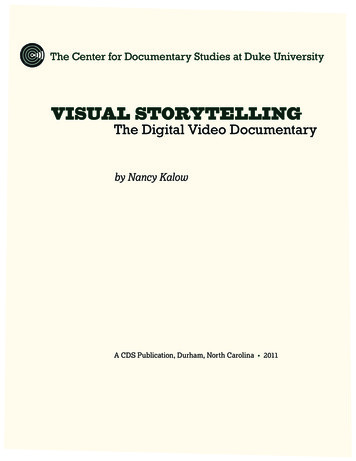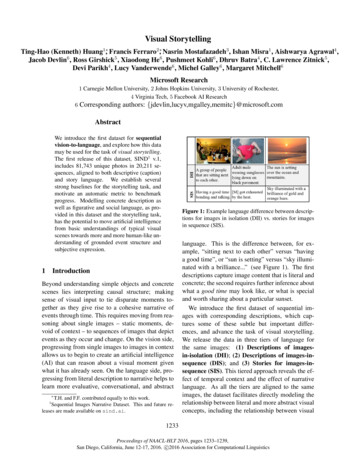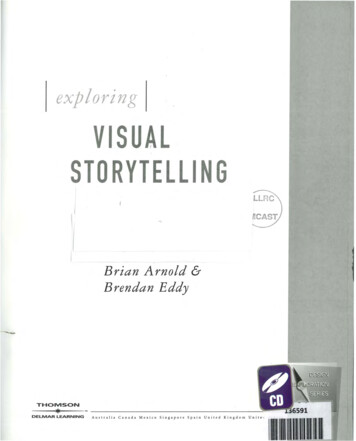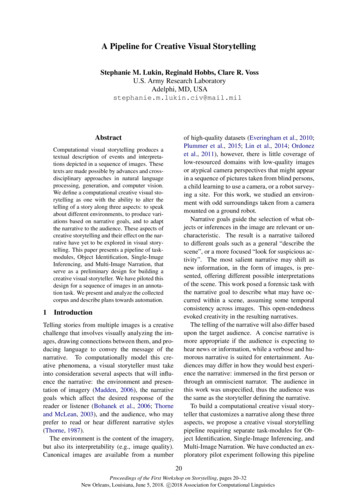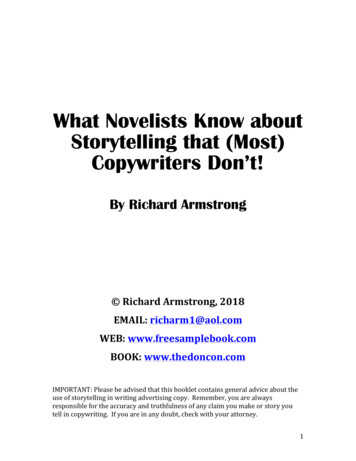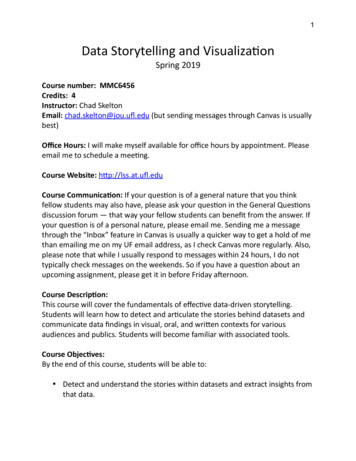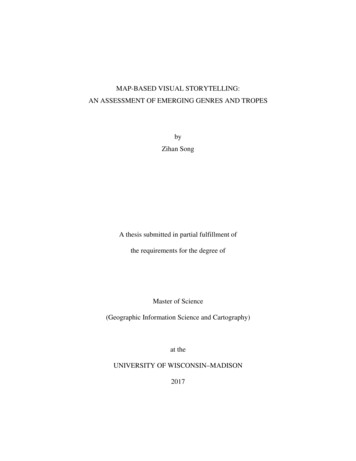
Transcription
MAP-BASED VISUAL STORYTELLING:AN ASSESSMENT OF EMERGING GENRES AND TROPESbyZihan SongA thesis submitted in partial fulfillment ofthe requirements for the degree ofMaster of Science(Geographic Information Science and Cartography)at theUNIVERSITY OF WISCONSIN–MADISON2017
TABLE OF CONTENTSTABLES AND FIGURESiACKNOWLEDGEMENTSiiCHAPTER 1: OVERVIEW AND SIGNIFICANCE11.1 Overview1.2 Problem Statement and Research Questions12CHAPTER 2: LITERATURE REVIEW52.1 Visual Storytelling, Cartography, and Data Journalism2.2 The Three-Act Narrative (RQ #1)2.3 Visual Storytelling Genres (RQ #2)2.4 Visual Storytelling Tropes (RQ #3)2.5 Visual Storytelling and Individual Differences (RQ #4)5681120CHAPTER 3: METHODS223.1 Participants3.2 Materials3.3 Procedure3.4 Analysis22243032CHAPTER 4: RESULTS354.1 Overall Results4.2 The Three-Act Narrative (RQ #1)4.3 Story Genre (RQ #2)4.4 Story Trope (RQ #3)4.5 Individual Differences (RQ #4)3539434852CHAPTER 5: CONCLUSION AND FUTURE DIRECTIONS575.1 Summary5.2 Limitations and Future Directions5.3 Design5.4 Significance57606263REFERENCES64APPENDICES68
iTABLES AND FIGURESTABLESTable 2.1: Vujaković’s (2014) Survey of Map-based Visual StoriesTable 2.2: The Segel and Heer (2010)’s Taxonomy of Visual Storytelling GenresTable 2.3: The Roth (2016) Taxonomy of Map-based Visual Storytelling GenresTable 2.4: Focus Attention Strategies (Roth, 2016)Table 3.1: The 2x2x2 Experimental Design Resulting in Eight Unique Map-based Visual StoriesTable 3.2: Story Content TableTable 3.3: Experiment Group AssignmentTable 3.4: Code SchemesTable 3.5: Analysis Methods for Independent Variables and Dependent VariablesTable 4.1: Participant Performance by Retention TasksTable 4.2: Overall ComprehensionTable 4.3: Participant Preference by GroupsTable 4.4: Participant Performance by ThemesTable 4.5: Comprehension by Story ThemesTable 4.6: Participant Preference by Story ThemesTable 4.7: Participant Performance by GenresTable 4.8: Comprehension by GenresTable 4.9: Participant Preference by GenresTable 4.10: Genre PreferenceTable 4.11: Participant Performance by TropesTable 4.12: Comprehension by TropesTable 4.13: Participant Preference by TropesTable 4.14: Trope PreferenceTable 4.15: Individual Differences with Retention and ComprehensionTable 4.16: Individual Differences with Story 51525456FIGURESFigure 2.1: The Traditional Three-Act Narrative After Young (2012)Figure 2.2: Visual Storytelling GenresFigure 2.3: Setting the Mood in Prison/PrincetonFigure 2.4: Enforcing Linearity in Snow Fall (partial)Figure 2.5: Information Dosing in Amazonia under Threat (partial)Figure 2.6: Visual Simile in Snowzilla (partial)Figure 2.7: Effective Redundancy in How the Recession Changed UsFigure 2.8: Voice in They Would Not Take Me There; People, Places, and Stories from Champlain’sTravels in Canada, 1603-1616Figure 2.9: Focus attention in Assessing the Damage and Destruction in GazaFigure 2.10: Using Color to Focus Attention: Cease-Fire Takes EffectFigure 2.11: Using Leader lines to Focus Attention: US Base Opponent Wins Okinawa Governor PollFigure 3.1: Participants’ Background CharacteristicsFigure 3.2: Qualtrics Interface Used for ExperimentsFigure 3.3: Design Consistency across PanelsFigure 4.1: Words Clouds Generated from Comprehension8912131415151617191923252642
iiACKNOWLEDGEMENTSI would first like to thank my advisor Robert Roth. I want to thank you for taking me as astudent, giving me the opportunity to study abroad and pursue cartography as a career. Youalways were patient with me and gave me helpful guidance throughout my research. I appreciateyour dedication to details and how you always pushed me to do my best throughout my research.I could not finish my thesis without your help. You are the best advisor and the best editor! Thiswork was supported by Rob's Career Grant #1555267.I also want to thank my committee members, Qunying Huang and Tanya Buckingham.Qunying, you provided me with extremely useful feedback on method design and statisticalanalysis. Those office hours were very helpful and I appreciate all your input as my committeemember. Tanya, thank you for your design advice, and your feedback after the defense made methink more deeply about my research. I really enjoyed working in the Cartography Lab underyour leadership!I owe a huge thank you to the Cart Lab community: Daniel Huffman, Carl Sack, AliciaIverson, Leanne Abraham, Chelsea Nestel, Ross Thorn, and Scott Farley. Your feedback duringmy thesis research and my two-year study at UW were invaluable and will contribute to mydesign approach throughout my career. In particularly thank you to my cohort colleagues KristenVincent and Meghan Kelly. Your advice and feedback made all of my designs and papers better.I couldn’t finish my study without their help and advice! I also want to thank all the greatstudents in Geography 370: I learned a great deal from you all during my three semesters inGeography 370. It is a great class, and I hope you continue to post your gorgeous maps in thehallway for years to come.Last but not least, thank you Max for being supportive while I was finishing thesis, class work,and also finding a job. Thank you for all your encouragement during all my irritable
iiimoments. The future is unknown and kind of scary, but I am glad to have your support through itall.
1CHAPTER 1: OVERVIEW AND SIGNIFICANCE1.1 OverviewStorytelling is fundamental to cartography (Robinson et al., 2015). The 4th century Classic ofMountains and Seas told the story of mythic of Ancient China; the medieval Beatine maps toldthe story of Christian Genesis; Ogilby's Britannia Atlas of 1675 told the story of risinginterconnectedness of British transport and trade (Brown, 1979). Historically, these spatializedstories unfolded through a set of individual, static maps (Haft, 2011). With changes in new mediaand web technology, map-based visual stories are both more accessible and more influentialtoday than ever (Cairo, 2012). Further, telling stories with maps has become an increasinglyimportant theme in cartographic research on geovisualization, volunteered geographicinformation, and the Geoweb, among others (Caquard, 2013). Here, map-based visualstorytelling describes the use of a purposeful and partial sequence of maps and informationgraphics to advance a linear spatial story (Roth, 2015).Increasingly, the use of maps and information graphics for visual storytelling is framed asdata journalism: news stories supplemented and even generated by analysis and presentation ofdigital information (Gray, Chambers, & Bounegru, 2012). Many news organizations includingthe Guardian, the New York Times, and the Washington Post regularly incorporate informationgraphics into their news stories, a change perhaps reflecting the transition of journalism from aprimarily print to a primarily digital medium. These organizations purposefully combine text,graphics, and other annotations to lead the viewer step-by-step through a linear narrativestructure, telling the story from beginning to end (Segel & Heer, 2010).While journalists have a long history of using data-driven maps as evidence in their newsreports (Monmonier, 1989; Aksoy & Bayar, 2016), map-based visual storytelling arguably is
2more common today than ever due to the ubiquity of new media, or natively-digital and webbased mechanisms for authoring and sharing information (Cartwright, 1997). Map-based visualstorytelling now takes many forms in new media (Crampton, 2009) and has enabled the generalpublic to contribute their own stories using emerging technology (Haklay, Singleton, & Parker,2008). However, empirical research on the design of visual stories remains in its infancy both incartography (Caquard, 2013; Roth, 2015; Cartwright & Field, 2015) and the related field ofinformation visualization (Kosara & Mackinlay, 2013; Figueiras, 2014), resulting in few timetested guidelines for storytelling with maps.1.2 Problem Statement and Research QuestionsThere is limited empirical research on the design of map-based visual storytelling, a concerngiven the increased attention of visual storytelling in cartography, information visualization, anddata journalism. My research contributes to three dimensions of visual story design fundamentalto the success of the story, leading to three overarching research questions:1. Can a linear, three-act narrative be effectively applied to map-based visualstorytelling? A three-act narrative often is applied in literature and film, yet itspotential for visual storytelling and data journalism is only beginning to berecognized (Smith & Watson, 2010). A traditional three-act narrative includes a setup (Act 1), a conflict (Act 2), and a resolution (Act 3). Importantly, the traditionalthree-act narrative organizes a story in a linear manner, maintaining a consistentsequence across story elements as the plot unfolds. In this research, I designed twomap-based visual stories using a three-act narrative structure.
32.What is the influence of visual storytelling genres on the retention, comprehension,and preference of the story? A visual storytelling genre describes the structural andstylistic elements that separate a form of story (or other artwork) from others (Roth,2016). As reviewed in Chapter 2, Segel and Heer (2010) offered a taxonomy of sevenvisual storytelling genres, which has been revised by Roth (2016) for the specificapplication of map-based visual storytelling. In this research, I examined differencesin story comprehension, preference, and retention between two specific visualstorytelling genres: longform infographics and dynamic slideshows.3. What is the influence of visual storytelling tropes on retention, comprehension, andpreference of the story? A visual storytelling trope describes a literary or rhetoricaldevice used to advance a story, much like a figure of speech in literature (Roth,2016). I examined one important trope used in visual storytelling: focus attention, ordesign elements that attract the reader’s attention to important elements of the story(Gershon & Page, 2001). I investigated the impact of two focus attention strategiescommonly used in cartography and information visualization (Robinson, 2011): colorhighlighting and leader lines. I provide additional background on genres and tropes inChapter 2.4. What is the influence of individual differences of the reader on retention,comprehension, and preference of the story? Multiple personal characteristics caninfluence retention, comprehension, and preference—and therefore the success—of avisual story design. Designers must consider ability, expertise, and motivation duringmap design (Roth, 2013). Because this research addresses the use of maps in complexstories of timely, sometimes controversial events, prior beliefs about the story topic
4also were considered to determine if and to what degree visual stories may causereaders to shift their perspectives.I administered an online map survey with a 2x2x2 factorial design to address the aboveresearch questions. I designed two map-based visual stories using a traditional three-actnarrative: a first on U.S. sea-level rise and a second on U.S. presidential campaign donations. Ithen modified each story systematically to produce versions in two genres (longforminfographics, dynamic slideshows) and two focus attention strategies (color highlighting andleader lines), resulting in a total of eight different designs. Each design was evaluated byretention, comprehension, and preference, taking into account a range of factors regardingindividual different.Compared to its increasing popularity, research in map-based visual storytelling iscomparatively rare. This study filled this important gap in the cartography by examining theutility of a three-act narrative for map-based visual storytelling. It also is the first study toexplicitly assess emerging visual storytelling genres and tropes. As discussed in Chapters 4 and5, envisioning cartographic design as visual storytelling provided useful, as the three-actnarrative generally was a successful approach for packaging the information, yet not all visualstorytelling designs performed equally. Visual storytelling design matters.This thesis proceeds with four additional chapters. In Chapter 2, background on the topicsof map-based visual storytelling and narrative structure are provided, as well as an overview ofgenres and tropes. The story design protocol and analysis procedure are described in Chapter 3.Results of the online survey study are presented in Chapter 4. Final thoughts on and futuredirections for research on map-based visual storytelling are provided in Chapter 5.
5CHAPTER 2: LITERATURE REVIEW2.1 Visual Storytelling, Cartography, and Data JournalismAlthough relatively limited empirical research has been conducted on map-based storytelling incartography over the past 50 years (see Monmonier, 1989, for one example), the terms “storymap” and “spatial narrative” have become buzzwords in professional cartography. Today, mapbased visual stories are tools for providing an explicit, spatial, and visual complement to theimplicit geographic components of a textual story or argument (Caquard & Cartwright, 2014).Further, there is growing interest in exploring the relationship between maps and stories beyondpublic communication: maps are becoming a visual tool to express the geographic dimension ofpersonal experiences (Sparke, 1998; Caquard, 2013; Pearce, 2008).This upward trend in map-based visual stories perhaps is part of the rise in datajournalism introduced in Chapter 1 (Cairo, 2012). Data journalism is an iterative process thatincludes collecting disparate data, analyzing and filtering the collected data, visualizing the data,and ultimately forming a story that hinges upon key insights in the data (Weber & Rall, 2012;Rogers, 2014). Thus, the data journalism process is much like the highly iterative process wefollow in cartographic design: both journalist and cartographer are active in shaping anexplanation of the provided graphics, images, and text (Muehlenhaus, 2013). Vujaković (2014)characterized the kind of themes receptive to map-based visual, ranging from environmentalissues to politics (Table 2.1). Nearly any story lends itself to map-based visual storytelling, as allevents occur in spatial or geographic contexts.
6ThemesSub-themesA. Politics: Internal1. Government, legislation, electoral, parties, non-violent protest/ strikes2. Riots, terrorism, civil conflict/ war, secession movements, coupesB. Politics: International3. International relations, negotiations, agreements (non- trade)4.Military conflict/ war, defense issues, territorial/ resource disputesC. Disasters/ Accidents5.Large-scale disasters, (earthquakes, floods, etc.), epidemics6. Accidents (transport, etc.), explosions & fires, industrial disasters,weather problems (e.g. avalanche)D. Environment and Science7. General science, natural science, engineering, medical8. Environmental problems/ impacts, pollution9. Transportation systems, development and planning10. Land use/ resource planning & conservation, public works,neighborhoodsE. Society11. Demography/ social trend, housing, employment, education12. Crime, courts/judicial, police, missing persons13. Social disasters (famine, refugees)F. Cultural affairs14. History & archaeology, heritage, the art and “media”15. Travel, tourism, recreation and sport16. Human interest/ ‘odd events’, religion, VIPs/ Royals, scandals (nonpolitical), minor accidents (few people)G. Economics17. Business & finance, industry18. Macro-economics, trade agreements, international, monetary issues, aidand economic developmentTable 2.1: Vujaković’s (2014) Survey of Map-based Visual Stories. The research reported here draws examplesfrom A. Politics: Internal, and D. Environment and Science.2.2 The Three-Act Narrative (RQ #1)The concepts of “narrative” and “story” are not the same. Narrative describes the structuring ofstory elements―organized into a sequence of frames or panels in a visual narrative―while storyis the addition of unique content to a particular narrative structure (Gershon & Page, 2001; Segel& Heer, 2010). Convention in literature and film has led to a widely recognizable three-actnarrative commonly applied to structure a story (Smith & Watson, 2010):Act 1: The narrative begins with a set-up act introducing the setting, key characters, andproblem context. The setting provides basic information for building an overall scene for theaudience, putting them in a specific time, place, and social context. The set-up also often
7includes a hook, or an exciting early scene that captures the attention of the audience andencourages them to continue reading. Next, key characters who act out the narrative areintroduced, and may include protagonists, the leading or hero characters, and antagonists, theopposing or anti-hero characters who contend with the protagonists or represent an alternativepoint of view. Finally, the set-up provides other information about the problem context that laterwill be necessary the audience to understand the unfolding narrative.Act 2: The narrative then progresses into the conflict act, which first intervenes with thecatalyst, or key issue driving the story, and then slowly builds suspense through rising plotpoints. The conflict often is the most important and the longest act in a story. The catalystproduces a tension among characters, particularly between the protagonist and antagonist. Thecharacters and setting introduced in the set-up then respond to this tension through a series ofplot points, which provide the audience with new information about the problem to develop thenarrative, add tension, and build suspense. The characters react and evolve at each plot point, andthis character development humanizes the story and its characters for the audience.Act 3: The narrative concludes with the resolution act, where the narrative arc culminatesin a final confrontation and characters suggest and even choose among competing solutions tothe problem starting the conflict act. The resolution contains the dramatic climax of the narrative,or final plot point facing the protagonists and antagonists, bringing their character arcs together.Following the climax, characters again return to their own paths (some may be discontinued),representing different solutions to the problem. The resolution concludes with the denouement inwhich remaining matters are explained or resolved, or several narrative elements are left for theaudience to determine in a cliffhanger, stimulating their imagination and curiosity while allowing
8the audience to “fill the gaps” using their own experiences and predictions (Gershon and Page,2001: 35).In this way, map-based visual stories covering very different themes (e.g., Table 2.1) canshare similarities in their design if using the same narrative structure. Figure 2.1 illustrates theconventional three-act narrative and its components for visual reference (Young, 2012). Phillips(2012) describes eight ways that explicitly geographic characters can evolve during a traditionalthree-act narrative: cause and effect, convergence, divergence, oscillation, destruction, genesis,emergence, and metamorphosis. While numerous visual and cinematic storytelling deviates fromthis traditional narrative substantially (Muehlenhaus, 2014), the research reported hereconsistently applies the three-arc narrative to understand its utility for map-based visualstorytelling.Figure 2.1: The Traditional Three-Act Narrative after Young (2012).2.3 Visual Storytelling Genres (RQ #2)As introduced in Chapter 1, genres are categories of map-based visual story designs based oncoherent stylistic criteria. Segel and Heer (2010) propose seven basic genres of visual
9storytelling unspecific to cartography: magazine style, annotated chart, partitioned poster, flowchart, comic strip, slide show, and film/video/animation (Figure 2.2, Table 2.2). This seven-partclassification of genres is based primarily on the number of different elements or frames withinthe story, and the ordering of these elements in the visual presentation. Segel and Heer (2010)imagine the ability to mashup combinations of these genres, and to supplement each withinteractive and dynamic content.Figure 2.2: Visual Storytelling Genres. The Segel and Heer (2010) taxonomy of visual storytelling genres largelyfocus on newspaper, magazine, or printed static material.GenresDefinitionmagazine stylean image embedded in a page of textannotated charta chart with additional doses of information provided as annotationspartitioned postera multi-view visualization with a loose order to its images, photos, and other elementsflow charta diagram that represents the steps in a process with boxes of various shapes and theirorder with connecting directional arrowscomic stripa sequence of images arranged in interrelated panels to form a story that follows a strictlinear pathslide showa linear structure incorporating interaction mid-narrative within the confines of eachslide, allowing the user to further explore particular points of the presentationfilm/video/animationa series of rapidly changing static imagesTable 2.2: The Segel and Heer (2010)’s Taxonomy of Visual Storytelling Genres
10However, Kosara and Mackinlay (2013) argue that the majority of the genres proposedby Segel and Heer (2010) are influenced by and therefore primarily limited to printed newspaperstories, and the film/video/animation genre including dynamic content is influenced primarily bypassive television news reporting and not emerging forms of new media dominating trends indata journalism and visual storytelling today.In response, Roth (2016) proposes a new taxonomy of visual storytelling genres specificto digital mapping that includes six genres: news maps (encapsulating most design for static orprint mapping listed by Segal & Heer, 2010), longform infographics, dynamic slideshows,narrated animations, personalized story maps, and multimedia experiences (Table 2.3). Ratherthan basing the classification on the number of elements or frames, the Roth taxonomydistinguishes each genre on the manner that graphics are presented to structure a linear, threeactive narrative (additional details on linearity in the next section). For example, dynamicslideshows enforce linearity interactively by requiring the reader to click through each storyframe, while longform infographics enforce linearity through reader scrolling of the browserwindow. Both strategies impose linearity in the way that the visual story is read. Thus, the Rothtaxonomy directly relates to the description of narrative introduced above, outlining differentvisual solutions for encoding a three-act (or other) narrative arc.GenreDefinitionStatic news mapslinearity enforced by layout, highlighting, and annotation on the mapLongform infographicslinearity enforced through the browser window’s scroll functionalityDynamic slideshowslinearity enforced clicking or swiping through panels presented individuallyNarrated animationslinearity enforced by the narration and advancement of time in the animationPersonalized story mapslinearity enforced by the userMultimedia experienceslinearity enforced through the layout and hyperlinking of text, images, and graphicsTable 2.3: The Roth (2016) Taxonomy of Map-based Visual Storytelling Genres
112.4 Visual Storytelling Tropes (RQ #3)As mentioned above, genres can be classified based on their sequential narrative structure, ortheir manner of enforcing linearity. A trope is a rhetorical device used to advance a narrative arc,with linearity being only one such trope (Roth, 2016). Drawing on Gershon and Page (2001),Roth identifies seven tropes that can be used in map-based visual storytelling.1. Setting the mood describes establishing and maintaining a visual tone congruent withthe setting, characters, and problem context. Some commonly manipulated design dimensions forsetting a mood include layout, linework form, color palette, and typography, each of which leadthe audience to approach the visual story from a specific emotive perspective (Muehlenhaus,2014). The Figure 2.3 example from the Atlantic evocatively sets the mood before launching thenarrative arc of the visual story. This longform infographics use black color and a dark tone forsetting an ominous, guarded mood at the beginning of the story. Setting the mood quickly alertsthe audience to the story theme and intrigues their curiosity.2. Enforcing linearity establishes a specific order for reading story content. As introducedabove, Roth (2016) argues that the solution for enforcing linearity is the primary way that visualstorytelling genres should be delineated. The Figure 2.4 example from the New York Times is amultimedia visual experience, enforcing linearity using vertical browser scrolling as well ashyperlinks and anchor tags to activate text descriptions, images and graphics, and video andanimated content in a planned order, resulting in a rich and linear multimedia experience.3. Information dosing reduces visual complexity by packaging content into a set ofimmediately understandable chunks of information. The Figure 2.5 example from NationalGeographic doses information across panels in a dynamic slideshow. As the user advancespanels in the slideshow, the map is updated or zoomed, with the information panel on the right
12updating to provide new story content. Such information dosing splits the story into several“bite-sized” portions to improve comprehension and retention.Figure 2.3: Setting the Mood in Prison/Princeton. (A) Genre: The example makes use of a longform inforgraphicto tell the story of comparison between costs in college and prison. (B) Tropes: The beginning of the visual storyuses bold colors and a large title to draw the audience’s attention and engage their interests. The dark color palettereinforces the “prison” theme and the coarse background texture sets a dark and serious tone for the story. Source:The Atlantic (2011).
13Figure 2.4: Enforcing Linearity in Snow Fall (partial). (A) Genre: This multimedia experience uses images,animations, and videos to tell the story of skiers and snowboarders’ experiences during an avalanche. (B) Tropes:The scroll bar (B1) combined with anchor tags (B2) enforce a linear narrative structure. Source: Branch et al.(2012).
14Figure 2.5: Information Dosing in Amazonia under Threat (partial). (A) Genre: These dynamic slideshows useprevious and next buttons (the and controls) to advance the linearly through multiple threats to the Amazon. (B)Tropes: Each slide contains a single dose of information, such as a small amount of text or a graphic, pairing thisinformation dosage with a dynamically zoomed central map. Source: National Geographic (2015)4. Visual simile derives or synthesizes new information to facilitate understanding oforiginal information. Some techniques include benchmarking, cartooning, and hyperrealism. TheFigure 2.6 example from the Washington Post uses a fictional cartoon depiction of a snowpersonto build a visual benchmark about the magnitude of the snow storm in the D.C. area, leaving adirect impression on the audience through visual simile.5. Effective Redundancy repeats important or unusual information to develop andreinforce story themes. For visual storytelling, effective redundancy may repeat colors orsymbols to develop visual motifs, or recurring visual elements example in the storyline. TheFigure 2.7 example from the Atlantic repeats blue and orange colors to represent two differenttime stamps, leaving a deep impression on the user about the story tension between before andafter the Great Recession.
15Figure 2.6: Visual Simile in Snowzilla (partial). (A) Genre: This multimedia experience uses images andhyperlinks to describe a 2016 snowstorm in Washington, D.C. (B) Tropes: The “Snowzilla” snowperson serves as avisual benchmark for displaying the amount of snow that fell in D.C. against the highly realistic basemap of theWashington Mall, combining two design solutions for visual simile. Source: Cai & Granados (2016).Figure 2.7: Effective Redundancy in How the Recession Changed Us. (A) Genre: The two-page static news mapspread outlines myriad ways that the U.S. has changed since the Great Recession. (B) Tropes: The storyredundantly applies blue and orange colors to represent conditions before and after the Great Recession,dramatically emphasizing tension and change in all graphics. Source: Lavin (2011)
166. Voice interjects subjective, character-driven, or audience-driven statements andreflections into the visual story. Voice personalizes and humanizes a story, allowing bothdesigners and the audience to draw from their experiences, opinions, and values wheninterpreting the story. The Figure 2.8 example from Pearce and Herrmann (2013) illustrates theeighteenth century historical landscape of Samuel de Champlain in the Upper Great Lakes furtrade. The story is told in three voices: Champlain’s, the indigenous people already in the area,and the cartographers’, a rich use of different voices to complicate the characters and buildtension in the visual story.Figure 2.8: Voice in They Would Not Take Me There; People, Places, and Stories from Champlain’s Travelsin Canada, 1603-1616. (A) Genre: This personalized story map tells the story of Champlain’s travels in Canada.(B) Tropes: The story applies various voices to embed personal experiences and emotions. Source: Pearce andHermann (2013).7. Focus Attention emphasizes important or unusual information that cannot be missed inthe story. The Figure 2.9 example from the New York Times uses thick, white frame annotationsand adjacent call-outs to draw the attention of the audience to destroyed buildings at specificsites, as these locations received the most extreme damage from the c
A visual storytelling genre describes the structural and stylistic elements that separate a form of story (or other artwork) from others (Roth, 2016). As reviewed in Chapter 2, Segel and Heer (2010) offered a taxonomy of seven visual storytelling genres, which has been revised by Roth (2016) for the spec
